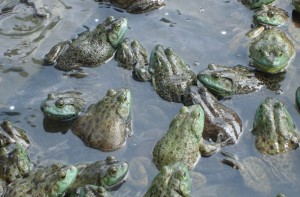Plagues of the Heart and Mind (Part 3)
By Sara Esther Crispe: January 13, 2014: Category Decoding the Tradition, Inspirations
Overcoming Our Nature: Frogs
 Anyone who has spent some time in the country knows the consistent and persistent noise that frogs make. But as annoying as that is, it doesn’t immediately appear to be anything as serious as a plague. Yet we are taught that the frogs in Egypt were absolutely everywhere, even in the ovens.
Anyone who has spent some time in the country knows the consistent and persistent noise that frogs make. But as annoying as that is, it doesn’t immediately appear to be anything as serious as a plague. Yet we are taught that the frogs in Egypt were absolutely everywhere, even in the ovens.
To understand the lesson of this plague, we need a bit of understanding as to the nature of a frog. Frogs are cold-blooded, amphibious creatures that hatch in cold climates. Now, unlike typical maternal behavior we see with many animals that do everything possible to protect their young and unborn, female frogs usually deposit their eggs into water where they hatch into tadpoles. Land-living frogs deposit their eggs in cold and moist holes and then abandon them. There is no watching over, no protection, no comfort. Baby frogs are born into this world and they are all on their own. This is why the Kabbalistic interpretation of frogs is that they represent a state of apathy, coldness and detachment. They may jump from thing to thing and make a lot of noise, but they are incapable of connecting to and with anything or anyone.
There are two main lessons that the frogs teach us. The first is that coldness, whether physical, emotional or spiritual, can cool off even the warmest of places. We should never underestimate how powerful negative emotions are. Walk into a room with a bad attitude and before you know it everyone around you will have come down a notch. Yet of course the opposite is true as well, bring joy and light into the darkness and it will automatically become illuminated.
The second lesson is that there is no such thing as not being able to change. If frogs can go against their nature, by jumping into the burning ovens, undoubtedly we can shift and transform as well. Often we feel stuck or that it is too late for something to be different. The frogs come to show us that if we are determined and we have a goal we want to achieve, we can do whatever is necessary and even what we had mistakenly believed was impossible.
As explained by the Lubavitcher Rebbe in connection to the plague of the frogs:
“Self-sacrifice” is not just the willingness to die for one’s beliefs; it is the way in which one lives for them. It is the willingness to sacrifice one’s “self” – one’s desires, one’s preconceptions, one’s most basic inclinations. Indeed, the Hebrew term for self sacrifice, mesirut nefesh, means both “giving of life” and “giving of will.”
Thus, the lesson of self-sacrifice is derived from a frog, a cold-blooded creature, who enters a burning oven. The ultimate test of faith goes beyond the issue of life and death – it is the ability to transcend one’s very nature for the sake of a higher truth.
http://www.interinclusion.org/inspirations/plagues-of-the-heart-and-mind-part-4/
http://www.interinclusion.org/inspirations/plagues-of-the-heart-and-mind-part-2/
Plagues of the Heart and Mind (Part 3),














;)
;)
;)
;)
;)
;)
;)
;)
;)
;)
